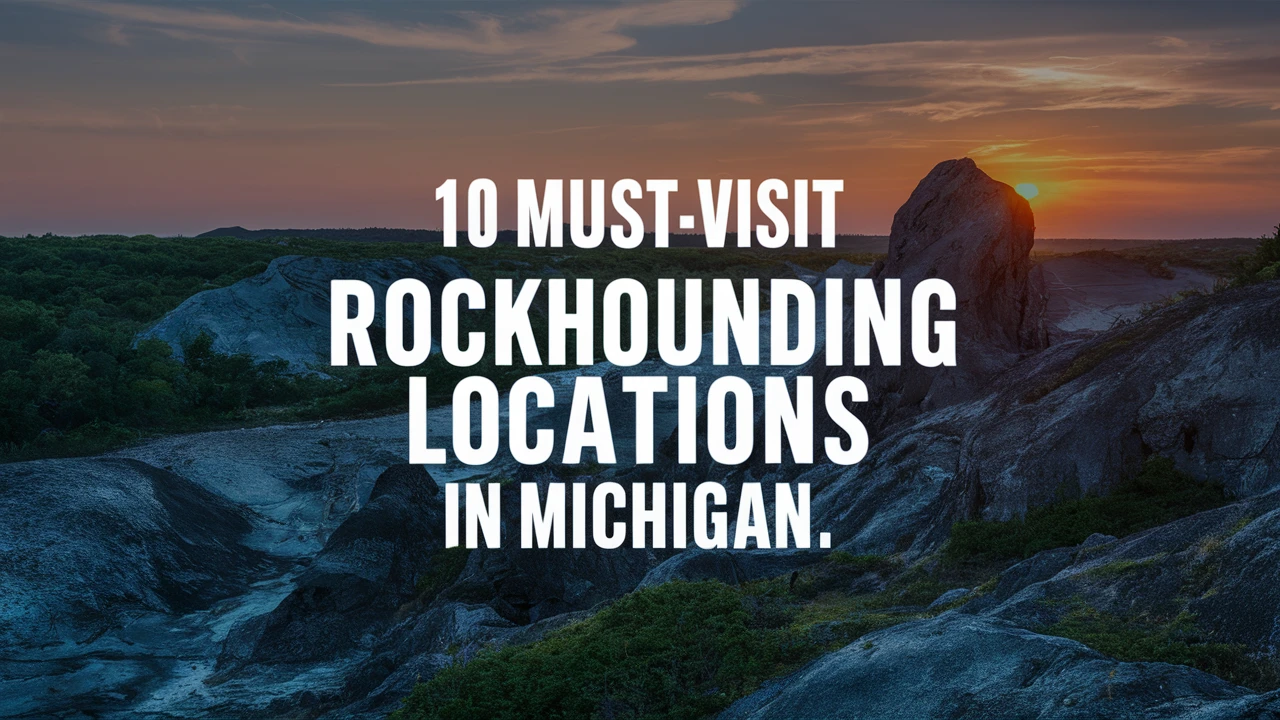
Michigan’s unique geological history makes it a treasure trove for rockhounding enthusiasts. From the iconic Petoskey stones along the Great Lakes shores to the copper deposits in the Upper Peninsula, the Great Lakes State offers an incredible variety of rocks, minerals, and fossils waiting to be discovered. As someone who’s spent countless hours exploring Michigan’s diverse geological landscapes, I’m excited to share these ten exceptional rockhounding locations that every collector should visit. Whether you’re a seasoned rockhound or just beginning your journey into this fascinating hobby, these sites offer something for everyone.
Understanding Michigan’s Geological Heritage
Before diving into specific locations, it’s essential to understand what makes Michigan such a unique destination for rockhounding. The state’s geological history spans billions of years, shaped by ancient seas, glacial activity, and volcanic processes. This diverse history has created an environment rich in:
- Precious and semi-precious stones
- Fossils from prehistoric marine life
- Native copper and other minerals
- Unique formations like the Petoskey stones
- Agates and other colorful specimens
Essential Tools for Michigan Rockhounding
Before heading out to any location, ensure you have the following equipment:
| Basic Tools | Purpose |
|---|---|
| Rock hammer | Breaking and extracting specimens |
| Safety goggles | Eye protection during hammering |
| Collection bags | Storing and transporting finds |
| GPS device | Navigation and location marking |
10 Prime Rockhounding Locations in Michigan
1. Petoskey State Park
Located along Little Traverse Bay, this park is famous for its Petoskey stones, fossilized colonial coral dating back 350 million years. Best hunting times are early spring and after storms when waves wash new specimens onto the beach. I’ve found that searching during overcast days makes the distinctive honeycomb pattern easier to spot.
2. Copper Harbor
The Keweenaw Peninsula’s crown jewel offers exceptional opportunities to find native copper specimens. Visit the old mine dumps and beach areas for:
- Native copper pieces
- Epidote crystals
- Agates
- Various copper minerals
3. Grand Marais Beach
Known for its impressive agate hunting, this Lake Superior beach offers:
| Type of Find | Best Time to Search |
|---|---|
| Lake Superior Agates | Early morning after storms |
| Jasper | Low tide periods |
| Quartz specimens | Spring thaw |
4. Rockport State Recreation Area
This former limestone quarry offers excellent fossil hunting opportunities. Look for:
– Devonian period fossils
– Calcite crystals
– Marine fossil specimens
– Limestone specimens
5. Bessemer Area
The historic iron mining region provides opportunities to find:
– Iron ore specimens
– Banded iron formations
– Various metamorphic rocks
– Mining-era artifacts
6. Lake Michigan Beach (Charlevoix)
Another prime Petoskey stone location, offering:
– Charlevoix stones
– Beach agates
– Fossilized coral
– Lake-tumbled specimens
7. Marquette Area Beaches
These Lake Superior beaches are known for:
– Datolite specimens
– Lake Superior agates
– Jasper
– Quartz varieties
8. Alpena Area
Famous for its fossil hunting opportunities:
– Devonian fossils
– Coral specimens
– Limestone formations
– Marine invertebrate fossils
9. Rapid River Falls
This Upper Peninsula location offers:
– Metamorphic rock specimens
– Quartz crystals
– Mineral specimens
– River-tumbled stones
10. Drummond Island
An excellent location for fossil hunting:
– Ordovician fossils
– Coral specimens
– Puddingstones
– Various minerals
Legal Considerations and Best Practices
When rockhounding in Michigan, always remember:
- Obtain necessary permits for state parks
- Respect private property boundaries
- Follow leave-no-trace principles
- Check local regulations before collecting
- Limit collection to reasonable amounts
Seasonal considerations:
| Season | Best Locations | Special Considerations |
|---|---|---|
| Spring | Beach locations | After winter ice melt |
| Summer | Inland sites | Early morning to avoid heat |
| Fall | All locations | Less crowded, comfortable weather |
| Winter | Limited access | Focus on research and planning |
Tips for Successful Rockhounding
1. Research your locations thoroughly before visiting
2. Check weather conditions and tides when applicable
3. Bring proper documentation and permits
4. Pack safety equipment and first aid supplies
5. Document your finds with photos and location notes
6. Join local rockhounding groups for shared knowledge
7. Consider seasonal timing for optimal hunting
8. Bring adequate water and supplies
9. Use proper tools and collection methods
10. Clean and properly store your specimens
Conclusion
Michigan’s geological diversity offers rockhounds an incredible variety of collecting opportunities. From the copper-rich Keweenaw Peninsula to the fossil-laden shores of the Great Lakes, each location provides unique specimens and experiences. Remember to always practice responsible collecting, respect local regulations, and share your knowledge with fellow enthusiasts. The joy of discovering your first Petoskey stone or perfectly formed agate makes every trip worthwhile.
Key Takeaways
- Michigan offers diverse rockhounding opportunities across the state
- Always check local regulations and obtain necessary permits
- Different seasons offer varying collecting opportunities
- Proper tools and safety equipment are essential
- Documentation and research enhance the collecting experience
Frequently Asked Questions
Do I need a permit to collect rocks in Michigan?
While many public beaches and areas allow casual collecting, some state parks and protected areas require permits. Always check local regulations before collecting.
What’s the best time of year for rockhounding in Michigan?
Spring and fall offer the most comfortable conditions, with spring particularly good after winter storms have uncovered new specimens.
Can I sell the rocks I find in Michigan?
Generally, rocks collected for personal use can be sold, but commercial collection may require special permits. Check local regulations for specific requirements.
What’s the best way to clean Petoskey stones?
Clean with water and a soft brush, then polish with fine-grit sandpaper. Some collectors use mineral oil to enhance the pattern.
Are there any dangerous areas to avoid while rockhounding?
Avoid old mine shafts, unstable cliffs, and private property. Always be aware of tide changes when beach collecting.
What tools are essential for beginning rockhounds?
Start with a basic kit including a rock hammer, safety goggles, collection bags, and a field guide to local specimens.
How can I identify the rocks I find?
Use field guides, join local rockhounding groups, or consult with local geology museums and universities for identification help.
Is it legal to collect fossils in Michigan?
Common fossils can typically be collected from public areas, but rare specimens may be protected. Check with local authorities for specific guidelines.
What’s the best way to transport delicate specimens?
Wrap specimens individually in paper or soft cloth, and use sturdy containers with padding to prevent damage during transport.
Are there any rockhounding clubs in Michigan?
Yes, Michigan has several active rockhounding clubs that offer field trips, workshops, and shared knowledge. Check online or with local geology museums for club information.


